Deulkkae
| Deulkkae | |
|---|---|
| | |
| deulkkae growing in Gimpo | |
| Scientific classification | |
| Kingdom: | Plantae |
| (unranked): | Angiosperms |
| (unranked): | Eudicots |
| (unranked): | Asterids |
| Order: | Lamiales |
| Family: | Lamiaceae |
| Genus: | Perilla |
| Species: | Perilla frutescens |
| Subspecies: | P. frutescens var. frutescens |
| Trinomial name | |
| Perilla frutescens var. frutescens (L.) Britton | |
| Synonyms | |
Deulkkae(들깨, Korean pronunciation: [tɯl.k͈ɛ]), Perilla frutescens var. frutescens, or perilla is one of the two distinct varieties of Perilla frutescens. The other variety, Perilla frutescens var. crispa, is called shiso.
The leaf of deulkkae is called kkaennip(깻잎, Korean pronunciation: [k͈ɛn.nip̚]), or perilla leaf.
Deulkkae is an annual plant native to Southeast Asia and Indian highlands, and grown in Korean peninsula, Southern China and India.[3] The plant was introduced into Korea before Unified Silla era, when it was widely cultivated.[3]
Names
In Korean, the name kkae(깨) refers to both the plant and the seed of sesame and perilla.[4] Sesame is called chamkkae(참깨), which literally means "true kkae", while perilla is called deulkkae(들깨), which literally means "wild kkae". Since sesame is considered as the regular kkae in Korean-speaking communities, kkae has often been translated into sesame. This (mis-)translation custom thus gave the nickname "wild sessame" to deulkkae.
The plant is called egoma(エゴマ/荏胡麻) in Japanese, and báizĭsū(白紫苏) in Chinese.
Description
Deulkkae is an annual plant growing 60–90 centimetres (24–35 in) tall, with hairy square stalks.[5]
The leaves are opposite, 7–12 centimetres (2.8–4.7 in) long and 5–8 centimetres (2.0–3.1 in) wide, with an broad oval shape, pointy ends, serrated(saw-toothed) margins, and long leafstalks. The leaves are green with occasional touches of purple on the underside.[5]
The flowers bloom on racemes at the end of branches and the main stalk in August and September. The calyx, 3–4 millimetres (0.12–0.16 in) long, consist of upper three sepals and the hairy lower two. The corolla is 4–5 millimetres (0.16–0.20 in) long with its lower lip longer than the upper. Two of the four stamens are long.[5]
The fruit is a schizocarp, 2 millimetres (0.079 in) in diameter, and with reticulate pattern on the outside.[5] Deulkkae seeds can be soft and hard, being white, grey, brown, and dark brown in colour[6] and globular in shape.[7] 1000 seeds weight about 4 grams (0.14 oz).[7] Deulkkae seeds contain about 38-45% lipid.[8][9][10]
Cultivation
In its natural state, the yield of deulkkae is not high. If the stem is cut about 5 centimetres (2.0 in) above ground level in summer, new stalk grows and it produces more fruit. Leaves can be harvested from the stem that cut off in summer.
The leaves are harvested throughout summer and autumn, and the seeds are harvested in autumn when the fruits are ripe. To collect deulkkae seeds, the whole plant is harvested and the seeds are beat out of the plant, before spread for sundry.
Culinary use
Seeds
In Korean cuisine, deulkkae seeds are either roasted and grounded into powder called dulkkaetgaru(들깻가루, Korean pronunciation: [tɯl.k͈ɛt̚.k͈a.ɾu]), or used to make perilla oil called deulgireum(들기름, Korean pronunciation: [tɯl.gi.ɾɯm]).
Toasted deulkkae powder is used as condiment when making guk(soup), namul(seasoned vegetable), guksu(noodles), kimchi, and eomuk(fish cake). It is also used in desserts. Yeot and several tteok(rice cake) varieties can be coated in toasted deulkkae powder. In Korean-style western food, toasted deulkkae powder is used in salad dressing as well as in dipping sauce.
Seed oil
Toasted perilla oil is usually for culinary use, mainly in Korean cuisine. It is used for marinating namul, coating gim(a kind of laver), or pan-frying jeon(fried pancake). Culinary use of perilla oil is more common in the southern part of Korea as perilla is not cultivated in the colder northern areas.[11] The untoasted perilla oil was used used for non-culinary purposes: for lamps, for oilpaper, etc. The press cake remaining after pressing perilla oil is used as fertiliser or animal feed.
Leaves
In Korean cuisine, kkaennip, the perilla leaves, is used fresh as ssam vegetable or pickled in soy sauce or soybean paste to make jangajji. It is used as namul vegetable, or as herb in the preparation of many dishes, including meat dishes and fried rice. The kimchi made of perilla leaves are called kkaenip kimchi. In Korean-style western food, perilla leaves are sometimes used to substitute basil.
Gallery
-
deulkkae field
-
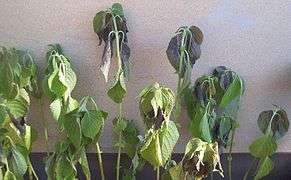
unwatered deulkkae
-
deulkkae flower
-
deulkkae raceme
-
kkaennip(deulkkae leaves)
-
deulkkae fruit
-
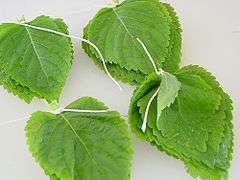
washed kkaennip
-

kkaennip jeon
-
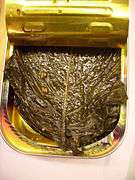
canned kkaaennip jangajji
-
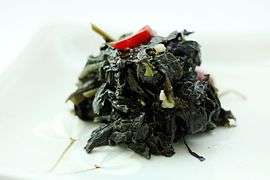
stir-fried kkaennip in perilla oil
-
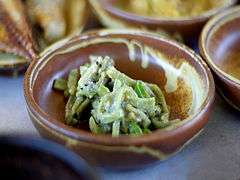
deulkkae powder used in namul dressing
-
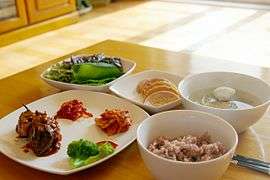
fresh kkaennip as a side dish
See also
References
- 1 2 "Taxon: Perilla frutescens (L.) Britton var. frutescens". U.S. National Plant Germplasm System. United States Department of Agriculture. 29 October 2007. Retrieved 2 December 2016.
- 1 2 "Plants Profile for Perilla frutescens frutescens (beefsteakplant)". Natural Resources Conservation Service. United States Department of Agriculture. Retrieved 2 December 2016.
- 1 2 "들깨" [deulkkae]. Britannica Online (in Korean). Encyclopaedia Britannica. Retrieved 30 November 2016.
- ↑ "깨01" [kkae01]. Standard Korean Language Dictionary (in Korean). National Institute of Korean Language. Retrieved 29 November 2016.
- 1 2 3 4 "들깨" [deulkkae]. Korea Biodiversity Information System (in Korean). National Arboretum. Retrieved 30 November 2016.
- ↑ Lee, Ju Kyong; Ohnishi, Ohmi (2001). "Geographic Differentiation of Morphological Characters among Perilla Crops and Their Weedy Types in East Asia". Breeding Science. 51 (4): 247–255. doi:10.1270/jsbbs.51.247 – via J-STAGE.
For example, the Korean accessions of var. frutescens showed four different seed colors, i.e., white, gray, brown and dark brown, and had soft and hard seeds, wheareas Chinese and Japanese accessions showed white, brown and dark brown seed colors, and had only soft seeds.
- 1 2 Asif, Mohammad (2011). "Health effects of omega-3,6,9 fatty acids: Perilla frutescens is a good example of plant oils". Oriental Pharmacy & Experimental Medicine. 11 (1): 51–59. doi:10.1007/s13596-011-0002-x. ISSN 1598-2386. PMC 3167467
 . PMID 21909287 – via Springer.
. PMID 21909287 – via Springer. - ↑ Shin, Hyo-Sun (1997). "9. Lipid Composition and Nutritional and Physiological Roles of Perilla Seed and its Oil". In Yu, He-Ci; Kosuna, Kenichi; Haga, Megumi. Perilla: The Genus Perilla. London: CRC Press. p. 93. ISBN 9789057021718 – via CRCnetBASE.
Perilla seed contains about 38-45% of lipid (Sonntag, 1979; Vaughan, 1970).
- ↑ Sonntag, Norman O.V. (1979). "Fat splitting". Journal of the American Oil Chemists’ Society. 56 (11): 729a–732a. doi:10.1007/BF02667430. ISSN 0003-021X – via Springer.
- ↑ Vaughan, John G. (1970). The Structure and Utilization of Oil Seeds. London: Chapman & Hall, Ltd. pp. 120–121.
- ↑ Pettid, Michael J. (2008). Korean Cuisine: An Illustrated History. London: Reaktion Books Ltd. p. 45. ISBN 9781861893482.
In addition to the three jang described above, other seasonings are highly important in Korean cuisine. Sesame oil (ch’am kiru˘m) and perilla oil (tu˘l kiru˘m) are the chief oils used in preparing foods, sauces and dipping sauces. Sesame oil, made by crushing sesame seeds, has a fragrant scent that accents the taste of food and is used in the preparation of meats and vegetables. Perilla oil, produced by crushing perilla seeds, is more common in the southern parts of the peninsula as perilla is not cultivated in the colder northern areas. Like sesame oil, this oil has a delicate fragrance, and is commonly used to prepare vegetable side dishes. It is also used as a dipping sauce for meats. These two oils are also used to lightly coat sheets of laver, a type of seaweed, before roasting, creating a popular and nutritious side-dish.